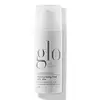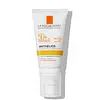Glo Skin Beauty Moisturizing Tint SPF 30+ Versus La Roche-Posay Anthelios Sun Intolerance Skin Sensitive to UV Radiation SPF50
What's inside
What's inside
 Key Ingredients
Key Ingredients

 Benefits
Benefits

No benefits
 Concerns
Concerns

 Ingredients Side-by-side
Ingredients Side-by-side

Water
Skin ConditioningC12-15 Alkyl Benzoate
AntimicrobialGlycerin
HumectantBis-Ethylhexyloxyphenol Methoxyphenyl Triazine
Skin ConditioningAlcohol Denat.
AntimicrobialDimethicone
EmollientEthylhexyl Triazone
UV AbsorberDrometrizole Trisiloxane
UV AbsorberButyl Methoxydibenzoylmethane
UV AbsorberStyrene/Acrylates Copolymer
Pentaerythrityl Tetraethylhexanoate
EmollientTitanium Dioxide
Cosmetic ColorantPropylene Glycol
HumectantDiisopropyl Sebacate
EmollientStearyl Alcohol
EmollientTalc
AbrasiveTocopherol
AntioxidantNylon-12
Synthetic Wax
AbrasiveAcetyl Dipeptide-1 Cetyl Ester
Skin ConditioningAluminum Hydroxide
EmollientAmmonium Acryloyldimethyltaurate/Steareth-8 Methacrylate Copolymer
Emulsion StabilisingAmmonium Polyacryloyldimethyl Taurate
Emulsion StabilisingCaprylyl Glycol
EmollientDimethicone Crosspolymer
Emulsion StabilisingDisodium EDTA
Glyceryl Isostearate
EmollientIsopropyl Lauroyl Sarcosinate
Skin ConditioningPEG-8 Laurate
EmulsifyingPentylene Glycol
Skin ConditioningPotassium Cetyl Phosphate
EmulsifyingScutellaria Baicalensis Extract
AntimicrobialStearic Acid
CleansingT-Butyl Alcohol
PerfumingTerephthalylidene Dicamphor Sulfonic Acid
UV AbsorberToluene Sulfonic Acid
Triethanolamine
BufferingXanthan Gum
EmulsifyingWater, C12-15 Alkyl Benzoate, Glycerin, Bis-Ethylhexyloxyphenol Methoxyphenyl Triazine, Alcohol Denat., Dimethicone, Ethylhexyl Triazone, Drometrizole Trisiloxane, Butyl Methoxydibenzoylmethane, Styrene/Acrylates Copolymer, Pentaerythrityl Tetraethylhexanoate, Titanium Dioxide, Propylene Glycol, Diisopropyl Sebacate, Stearyl Alcohol, Talc, Tocopherol, Nylon-12, Synthetic Wax, Acetyl Dipeptide-1 Cetyl Ester, Aluminum Hydroxide, Ammonium Acryloyldimethyltaurate/Steareth-8 Methacrylate Copolymer, Ammonium Polyacryloyldimethyl Taurate, Caprylyl Glycol, Dimethicone Crosspolymer, Disodium EDTA, Glyceryl Isostearate, Isopropyl Lauroyl Sarcosinate, PEG-8 Laurate, Pentylene Glycol, Potassium Cetyl Phosphate, Scutellaria Baicalensis Extract, Stearic Acid, T-Butyl Alcohol, Terephthalylidene Dicamphor Sulfonic Acid, Toluene Sulfonic Acid, Triethanolamine, Xanthan Gum
Ingredients Explained
These ingredients are found in both products.
Ingredients higher up in an ingredient list are typically present in a larger amount.
Also known as Avobenzone, this ingredient is a chemical sunscreen filter that provides protection in the UV-A range.
Avobenzone is globally approved and is the most commonly used UV-A filter in the world.
Studies have found that avobenzone becomes ineffective when exposed to UV light (it is not photostable; meaning that it breaks down in sunlight). Because of this, formulations that include avobenzone will usually contain stabilizers such as octocrylene.
However, some modern formulations (looking at you, EU!) are able to stabilize avobenzone by coating the molecules.
Avobenzone does not protect against the UV-B range, so it's important to check that the sunscreen you're using contains other UV filters that do!
The highest concentration of avobenzone permitted is 3% in the US, and 5% in the EU.
Learn more about Butyl MethoxydibenzoylmethaneTitanium dioxide is a mineral UV filter widely used in sunscreens and cosmetics.
It is one of only two UV filters officially classified as “mineral” by regulatory agencies, the other being zinc oxide.
Titanium dioxide provides broad-spectrum protection mostly in the UVB and UVAII range, with some protection in the UVAI range.
While its UVA protection isn’t as strong as zinc oxide’s, the difference is minor.
A common myth is that mineral UV filters reflect UV light. However, modern research shows titanium dioxide absorbs UV radiation like chemical filters (~95% absorption & 5% reflection).
Thanks to its non-irritating nature, titanium dioxide is suitable for sensitive, acne-prone, or redness-prone skin. It is unlikely to cause "eye sting" like other sunscreen ingredients.
A major drawback of this ingredient is its white cast and thick texture. This is why mineral sunscreens often leave a white cast and are less cosmetically elegant than chemical/hybrid sunscreens.
To improve white cast and spreadability, micronized or nano-sized titanium dioxide is often used.
There are ongoing concerns surrounding nano-titanium oxide's impact on marine ecosystems.
There is no conclusive evidence that any form of titanium oxide (or any other sunscreen ingredients) will cause harm to marine ecosystems or coral reefs. The science is still developing but many consumers are keeping a close eye on this issue.
Please note, many destinations have reef-safety sunscreen rules. For instance, the U.S. Virgin Islands advises all visitors to use non-nano mineral sunscreens.
Nano mineral sunscreens once raised safety concerns about absorption into skin.
Extensive research has shown that they do not penetrate healthy or damaged skin; they remain safely on the surface and the top layer of dead skin (stratum corneum).
You'll likely find titanium dioxide bundled with alumina, silica, or dimethicone. These ingredients help make titanium dioxide highly photostable; this prevents it from interacting with other formula components under UV light.
Learn more about Titanium Dioxide